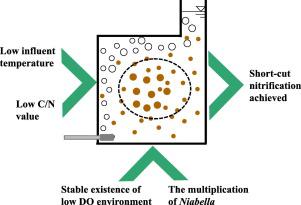Journal of Water Process Engineering ( IF 6.3 ) Pub Date : 2022-08-01 , DOI: 10.1016/j.jwpe.2022.103027 Xi Tian , Xuejiao Li , Penghui Dong , Zhimin Ren , Xiaona Ji , Dejun Bian

|
To solve the practical problem of the difficulty of denitrification of urban sewage caused by low-temperature and low-carbon sources, the micro-pressure swirl reactor (MPSR) was used to carry out a simulation study of low-carbon source sewage treatment when the influent temperatures were 15, 12, and 10 °C. The results showed that the MPSR process had the best sewage treatment effect at 12 °C, and the average removal rates of COD, NH4+-N, TN, and TP were 85.93 %, 99.17 %, 76.4 %, 94.78 %. Through the study of the denitrification process, it was found that the main composition of TN in the effluent was changed from NO3−-N to NO2−-N at 12 °C, and the MPSR system achieved short-cut nitrification. The DO duration results suggested that a larger low DO range and a longer low DO duration promoted the formation of short-cut nitrification at 12 °C. When the temperature further dropped to 10 °C, the short-cut nitrification of the system was inhibited by the increase of DO. The Niabella was a genus of bacteria involved in nitrification in MPSR system, and its large number ensured the low-temperature nitrification effect of MPSR. The existence of denitrifying phosphorus removal bacteria (Dechloromonas and Rhodoferax) ensured the removal effect of nitrogen and phosphorus in the system. Based on metabolic pathway analysis, it was confirmed that the MPSR system achieved short-cut nitrification under low-temperature and low-carbon sources, which the carbon source consumption was saved and the denitrification effect was improved.
中文翻译:

微压旋流反应器处理低温低碳源城市污水的处理效果及脱硝机理
【摘要】:针对低温低碳源导致城市污水脱硝难的实际问题,采用微压旋流反应器(MPSR)对低碳源污水处理进行模拟研究。进水温度分别为 15、12 和 10 °C。结果表明,MPSR工艺在12℃时污水处理效果最好,COD、NH 4 + -N、TN、TP的平均去除率分别为85.93%、99.17%、76.4%、94.78%。通过对反硝化过程的研究发现,出水TN的主要成分由NO 3 - -N变为NO 2 --N 在 12 °C 时,MPSR 系统实现了短程硝化。DO持续时间结果表明,较大的低DO范围和较长的低DO持续时间促进了12℃下短程硝化的形成。当温度进一步下降至 10 ℃时,系统的短程硝化反应受到 DO 增加的抑制。Niabella是MPSR系统中参与硝化作用的细菌属,其数量多保证了MPSR的低温硝化效果。反硝化除磷菌(脱氯单胞菌和红藻属)的存在)保证了系统中氮、磷的去除效果。通过代谢途径分析证实,MPSR系统在低温低碳源下实现了短程硝化,节省了碳源消耗,提高了反硝化效果。











































 京公网安备 11010802027423号
京公网安备 11010802027423号